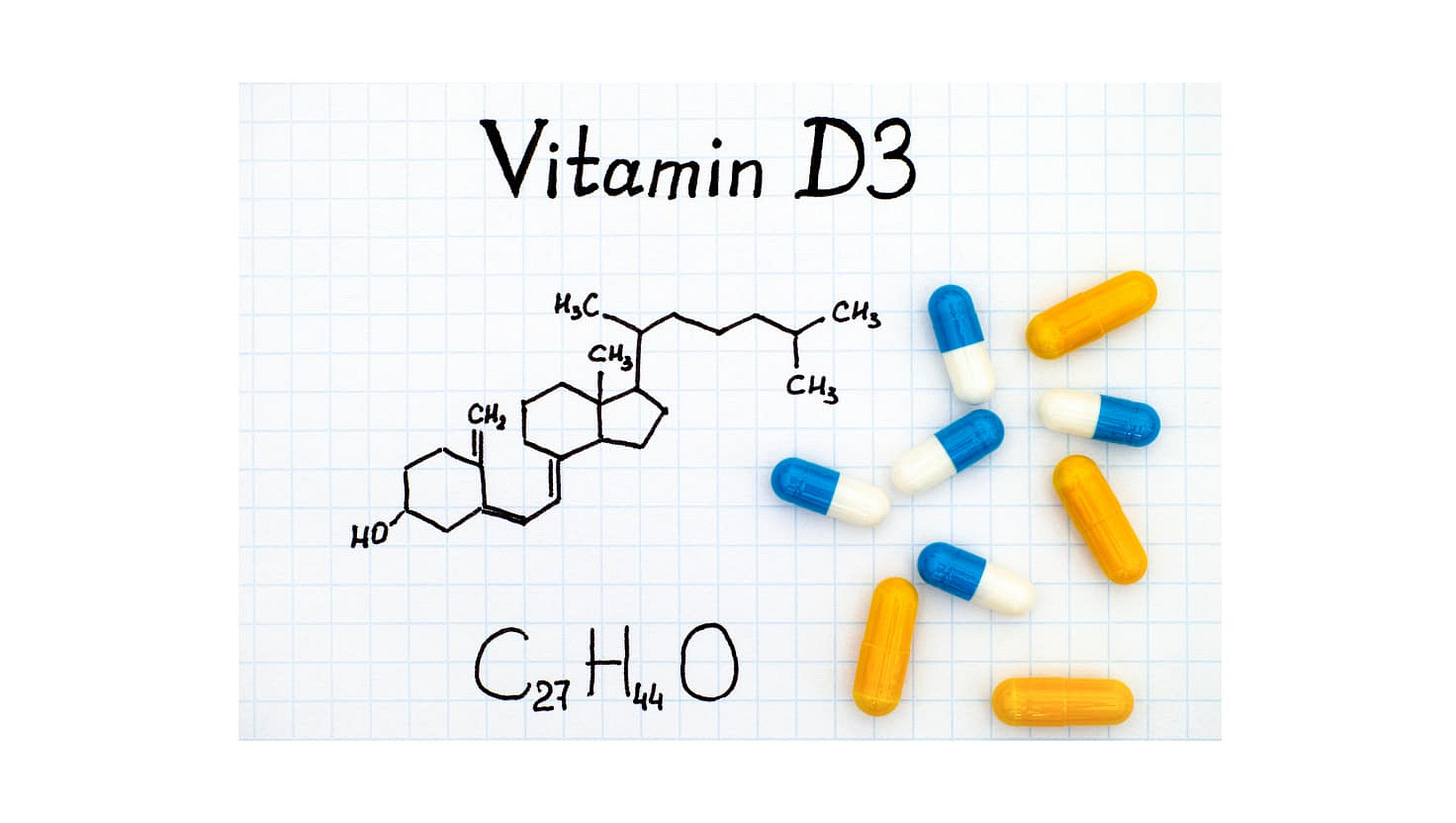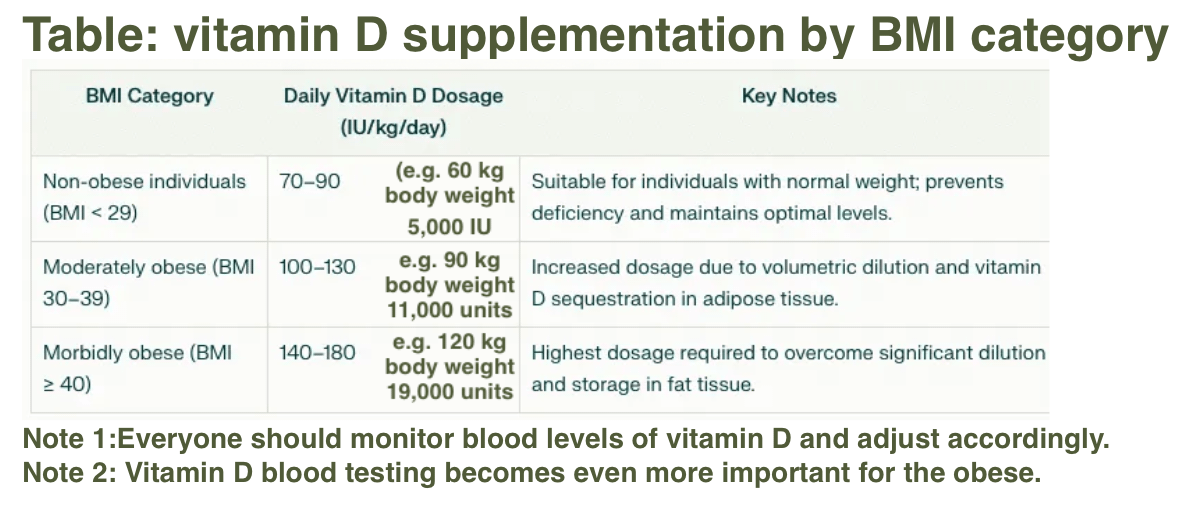Advantages of Vitamin D for your Health
I write this because I'm sick and tired of people saying they're too sick to come to my Pilates (There's so much you can do for your health!)
Article abridged and adapted from:
Understanding the Health Benefits of Vitamin D
by Sunil J Wimalawansa, MD, PhD, MBA, DSc. Prof. Medicine, Endocrinology & Human Nutrition
Picture: Food sources of Vitamin D are not sufficient to optimise our health (and we’re not getting enough from sunlight either!)
Quick Vitamin D guide for adults
Take 5,000 units daily of vitamin D3 because this will improve your health
At the same time, supplement with daily Magnesium and vitamin K (because this helps balance and enhance the vitamin D)
Don't supplement with Calcium at the same time as you take vitamin D (there is a modest risk of high blood calcium levels)
Have a vitamin D blood test done. Due to costs, doctors are discouraged from requesting this for you. You can phone the blood collection centre and book and pay for a Vitamin D test for yourself (Cost approx $75.00 in NZ).
These guidelines are safe for the vast majority of adults. Therefore, do not be intimidated by drug company-driven "official" information.
Picture: Futurebiotics capsules containing 5,000 units vitamin D and 90 mcg of K2 MK-7 (one small capsule daily) provide an easy first step to reducing colds, flus and winter misery.
Find it on iHerb now!
(I don’t receive a commission for providing this link)
Article summary
Vitamin D is essential
Calcitriol Systems: Mechanisms and Requirements
Different tissues have different vitamin D requirements
Broad Health Benefits of Vitamin D
Vitamin D deficiency (VDD) is widespread globally, even in regions with abundant sunlight
Evidence Supporting Optimal Vitamin D Levels
Limitations of Current Guidelines and Large Trials
Malfeasance on the part of Profit-seeking Big Pharma
Personalised Supplementation Strategies
Recommendations for Public Health
Conclusion
Dr Wimalawansa’s References
This author's References
Vitamin D is essential
Vitamin D is vital for overall health, playing key roles in musculoskeletal, immune, and cardiovascular functions.
Vitamin D's active form (Calcitriol) is synthesised in renal tubular cells In the kidneys) and released into circulation (where its primary role is maintaining Calcium levels in the blood).
Calcitriol is also synthesised in peripheral cells in response to immune signals (from the Toll-like receptors of the innate, or non-specific immune system). It reaches very high levels inside cells (when compared with the bloodstream), and has many wide-ranging health effects (not just bone maintenance).
If the body doesn't have reserves of Vitamin D ready to convert into Calcitriol, it cannot mount effective immune and other responses to stress and toxicity. Therefore, addressing vitamin D deficiency through supplementation and public health initiatives will reduce disease burden, improve health outcomes, and lower healthcare costs.
Calcitriol Systems: Mechanisms and Requirements
Picture: since it is almost impossible in today's world to get enough Vitamin D from diet and sun exposure alone, it is essential to supplement with vitamin D3
Different tissues have different vitamin D requirements
For example, musculoskeletal tissues function best at serum 50 ng/mL, whereas the cardiovascular and gastrointestinal systems require 30–40 ng/mL concentrations. For immune system optimisation, cancer prevention, and longevity, serum 25(OH)D levels exceeding 50 ng/mL are necessary [2, 3]. Table 1 presents the optimal serum 25(OH)D concentration ranges for various body systems and associated disorders.
Broad Health Benefits of Vitamin D
Vitamin D is indispensable for musculoskeletal health and reduces the risk and severity of numerous other diseases. The latter include cardiovascular diseases, diabetes, cancer, respiratory illnesses, chronic kidney disease, immune dysfunction, autoimmune conditions, neurological disorders such as Alzheimer's disease, and complications during pregnancy [6].
Vitamin D deficiency (VDD) is widespread globally, even in regions with abundant sunlight.
VDD is a major contributor to increased morbidity and premature mortality across a range of health conditions.
· In the United States, 40% are deficient or very deficient
· In Central Europe, deficiency levels exceed 50% [7].
· In tropical regions such as South Asia and the Middle East, VDD prevalence surpasses 60% [7].
Evidence Supporting Optimal Vitamin D Levels
Extensive clinical trials and observational studies have demonstrated robust associations between serum 25(OH)D levels and health outcomes. Maintaining 40–80 ng/mL concentrations is critical for protecting against infections, autoimmune diseases, and chronic conditions [1, 8]. These levels far exceed the outdated 20–30 ng/mL recommendations from bodies like the NIH, IoM (USA), NICE, and SCAN (UK). Current guidelines focus on skeletal benefits while neglecting broader systemic advantages, and we should replace them.
Limitations of Current Guidelines and Large Trials
Many recent randomised controlled trials (RCTs) evaluating vitamin D have failed to demonstrate benefits due to flawed designs.
Issues include:
· Inadequate participant selection resulting from the failure to measure baseline serum 25(OH)D levels [9],
· Inconsistent supplementation dosages and the study participants' self-supplementing behaviour were not checked.
· Single large doses *
· Infrequent doses *
(*Daily dosing is best)
Unfortunately, vitamin D guidelines have relied too heavily on flawed RCTs, leading to inadequate clinical recommendations.
Malfeasance from Profit-seeking Big Pharma
Since adequate to high levels of vitamin D might profoundly reduce our requirement for prescription medicines, the pharmaceutical industry has strong economic reasons for opposing moves toward higher dosage recommendations – multiple lines of evidence of malfeasance during the COVID epidemic support this view – see also Vitamin D acceptance delayed by Big Pharma following the Disinformation Playbook
https://orthomolecular.org/resources/omns/v14n22.shtml]
Personalised Supplementation Strategies
The following straightforward calculations provide an easy way to estimate an individual's daily vitamin D requirement accurately. Personalised supplementation based on body weight or BMI is recommended to achieve optimal serum 25(OH)D levels (Wimalawansa, SJ, Nutrients, 2022: https://doi.org/10.3390/nu14142997). A simplified formula categorises dosage requirements:
· Non-obese individuals (BMI < 29): 70–90 IU/kg/day (approximately 5,000 IU)
· Moderately obese (BMI 30–39): 100–130 IU/kg/day (approximately 11,000 IU)
· Morbidly obese (BMI ≥ 40): 140–180 IU/kg/day (approximately 19,000 IU)
Recommendations for Public Health -
(what government and hospital websites should say but don’t)
From a disease prevention perspective, non-obese adults (~70 kg) require a daily intake of 5,000–7,000 IU to maintain optimal serum 25(OH)D levels. Overweight and obese individuals need two to four times this amount due to volumetric dilution and sequestration (hiding away) in adipose tissue. Regular measurement of serum 25(OH)D is essential for at-risk populations, including older adults, pregnant women, individuals with darker skin tones, institutionalised persons, and those living in higher latitudes.
Conclusion
Vitamin D is an undervalued yet highly cost-effective natural agent with extensive health benefits beyond bone health. Despite mischaracterisations by conflicted scientists and physicians, evidence strongly supports its role in reducing the incidence and severity of various diseases and preventing premature deaths. There is an urgent need to revise the flawed vitamin D guidelines in most countries. Recommendations should focus on achieving serum 25(OH)D levels of 40–80 ng/mL through appropriate supplementation, routine screening, and safe sun exposure guidance. Implementing these measures can significantly reduce disease burdens, enhance longevity, lower healthcare costs, and improve global public health outcomes.
Dr Wimalawansa’s References:
(Note: Dr Wimalawansa martials hundreds of research papers to synthesise this presentation. It is extremely thorough).
1. Wimalawansa, S.J., Physiological Basis for Using Vitamin D to Improve Health. Biomedicines, 2023. 11(6).
2. Wimalawansa, S.J., Rapidly Increasing Serum 25(OH)D Boosts the Immune System, against Infections-Sepsis and COVID-19. Nutrients, 2022. 14(14).
3. Wimalawansa, S., Overcoming infections, including COVID-19, by maintaining circulating 25(OH)D concentrations above 50 ng/mL. Pathology & Lab. Medicine Int., 2022. 14: p. 37–60.
4. Hollis, B.W., et al., Circulating vitamin D3 and 25-hydroxyvitamin D in humans: An important tool to define adequate nutritional vitamin D status. J Steroid Biochem Mol Biol, 2007. 103(3-5): p. 631-4.
5. Wimalawansa, S.J., Physiology of Vitamin D-Focusing on Disease Prevention. Nutrients, 2024. 16(11).
6. Wang, H., et al., Vitamin D and chronic diseases. Aging Dis, 2017. 8(3): p. 346-353.
7. Johnson, D.D., et al., Vitamin D deficiency and insufficiency is common during pregnancy. Am J Perinatol, 2011. 28(1): p. 7-12.
8. Wimalawansa, S.J., Infections and Autoimmunity-The Immune System and Vitamin D: A Systematic Review. Nutrients, 2023. 15(17).
9. Wimalawansa, S.J., S.T. Weiss, and B.W. Hollis, Integrating Endocrine, Genomic, and Extra-Skeletal Benefits of Vitamin D into National and Regional Clinical Guidelines. Nutrients, 2024. 16(22).
10. Grant, W., Wimalawansa SJ, Pludowski P, Cheng R, Vitamin D: Evidence-based health benefits and recommendations for population guidelines. Nutrients, 2025. 17(2): p. 277.
This author's references and further reading
1. There Is No Such Thing as Vitamin D Toxicity
(better wording would be: "It's extremely rare")
https://www.drberg.com/blog/there-is-no-such-thing-as-vitamin-d-toxicity
2. Vitamin D Toxicity: Is This a Danger? (There is, but it's extremely rare!)
https://www.drberg.com/blog/vitamin-d-toxicity-is-this-a-danger
3. Dosing requirements: Overview How Much vitamin D? (This independent resource comes to the same conclusions as Dr Wimalawansa)
https://vitamindwiki.com/Overview+How+Much+vitamin+D
4. Vitamin D acceptance delayed by Big Pharma following the Disinformation Playbook
https://orthomolecular.org/resources/omns/v14n22.shtml
5. Yandex search:
Malfeasance on the part of Profit-seeking Big Pharma during COVID
https://yandex.com/search/?text=Malfeasance+on+the+part+of+Profit+seeking+Big+Pharma+during+covid&lr=113852
6. Tolerable Upper Intake Levels: Calcium and Vitamin D
DeLuca (2009) concluded that, overall, the toxicity of hypercalcemia becomes evident at vitamin D intakes above 25,000 IU/day… … Hathcock et al. (2007), following an analysis of more than 20 publications, concluded that there was no association between harm and intakes of 10,000 IU/day.
https://www.ncbi.nlm.nih.gov/books/NBK56058/










